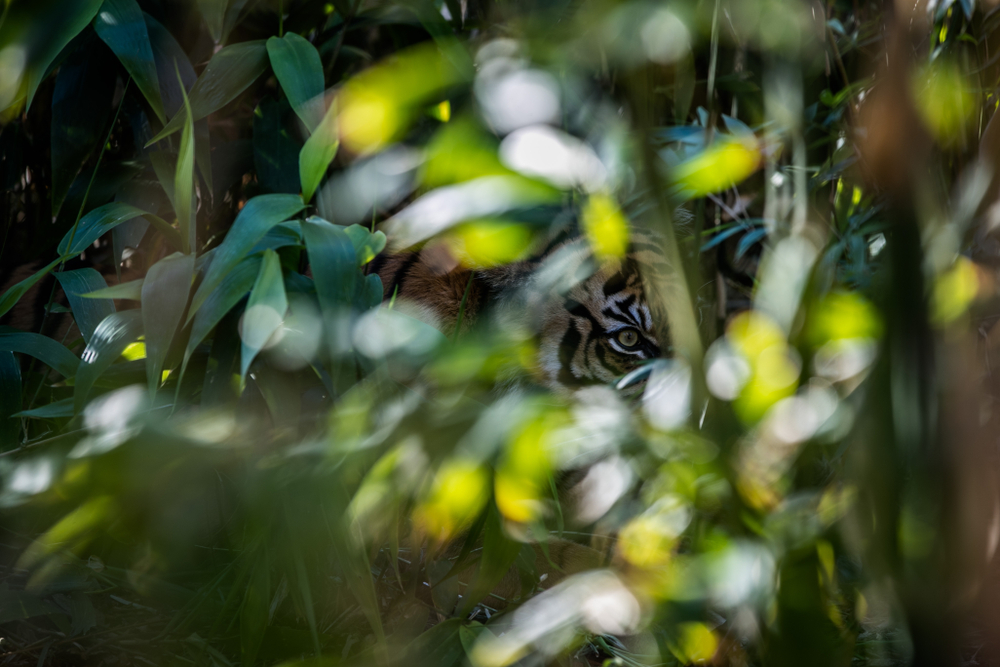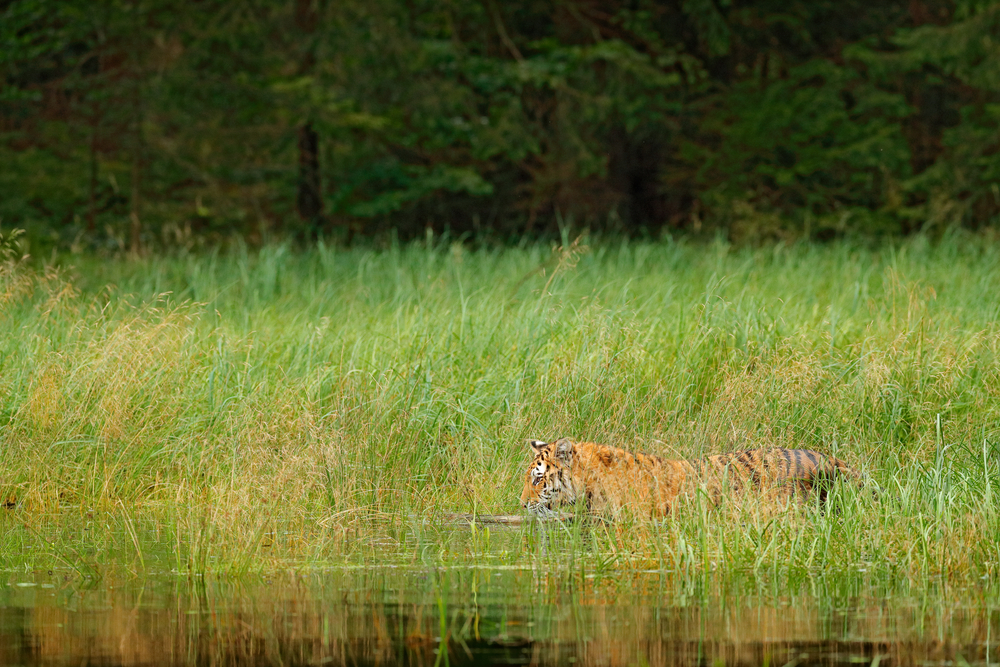Tigers are the largest of the big cat species and can easily overpower and subdue large prey. They are agile and fast and can sprint at speeds of up to 40 miles per hour for short distances. Their ability to stalk, ambush, and capture prey with precision makes them a top predator in their ecosystems. But how do they manage to stalk prey with stealth and remain hidden with their distinctive coat pattern?
As it turns out, their orange color provides effective camouflage in their natural habitat, which often consists of dense forests and tall grasslands. The disruptive patterning of their fur can blend well with the dappled sunlight and shadows in these environments. This allows tigers to approach prey more closely without being detected. They can stalk their prey with stealth, and the unique markings help them get within striking distance.
According to a recent study, the conspicuous orange coat makes tigers almost invisible even in a predominantly green forest – at least to the ungulates. Tigers appear orange to humans because most of us are trichromatic (or sensitive to all three primary colors). But boars, deer, and other tiger prey are dichromatic and only pick up green and blue light. They’re effectively colorblind to red, like some people. This means that they cannot distinguish between red-orange tones and green tones. So, an orange tiger, to the prey’s detriment, will seamlessly blend into the forest backdrop.
The researchers in this study used deep learning to replicate how the world looks like to dichromats so they could determine the best colors for camouflage for different animals. Their conclusion was that provided the prey animal cannot tell the difference between green and orange, there isn’t a need for the predator to develop a green coat to blend into the forest.

Orange is the most common color for tigers, with varying depths among different subspecies. The Siberian tiger, for example, has a golden orange coat and brown stripes, while Sumatran tigers have fur that’s burnished orange and black stripes.
But some tigers (like Bengal tigers) have white and black stripes, mostly due to mutation in their genes. Unfortunately, there are none left in the wild, mostly because their white fur does not blend in well as the orange one, making it hard to hunt. We also have black tigers which have wide stripes that are closely set so that their coat appears black.
So why do tigers have these colors?
It boils down to a combination of evolutionary adaptation and the intricate workings of pigmentation in their fur.
The coloration of an animal's fur, skin, and other tissues is determined by pigments, which are molecules that absorb and reflect certain wavelengths of light. In the case of tigers, the primary pigments responsible for their distinctive orange color are eumelanin and pheomelanin.

The presence of pheomelanin in a tiger's fur has an evolutionary advantage. Over millions of years, tigers with effective camouflage, achieved through a combination of eumelanin (dark stripes) and pheomelanin (orange background), would have had an advantage in hunting as well as their survival instincts.
Tigers are highly adaptable predators that inhabit a variety of terrains and landscapes across Asia. Their camouflage has evolved to suit nature's diverse designs, ensuring their effective hunting and survival. Here are some of the terrains and landscapes where tiger camouflage adapts accordingly:
Tigers in tropical and subtropical forests, such as those in India and Southeast Asia, often have a bright orange coat with black stripes. This coloration helps them blend into the dappled sunlight and dense vegetation of the forest floor.
In grasslands and savannahs, like those found in parts of India and Nepal, tigers typically have a more muted and lighter orange background, which allows them to blend into the tall grasses. The black stripes on their fur help break up their outline and make them less visible to prey.
Tigers that inhabit swamps and wetlands, as seen in parts of the Sundarbans mangrove forest in Bangladesh and India, may have a coat with a somewhat lighter and more muted orange hue to blend with the vegetation and water reflections.
In mountainous regions, like the Russian Far East and parts of China and North Korea, Siberian tigers adapt their camouflage with thicker fur, often appearing more golden in color. This adaptation helps them blend into the rocky terrain and snowy landscapes in the higher altitudes.
We cannot overstate the importance of preserving natural habitats for tigers, especially given their endangered status and the rapid decline in their numbers over the past century. Just a little over 100 years ago, an estimated 100,000 wild tigers roamed across Asia. Today, that number has dwindled to fewer than 4,500.
Habitat and wildlife preservation is not just about safeguarding this majestic creature; it's about protecting biodiversity, ensuring ecological stability, and securing the future of our planet. The plight of tigers is indicative of the broader crisis facing wildlife worldwide, as human activities continue to encroach on their habitats, leading to habitat loss, poaching, and the illegal wildlife trade.
Lions Tigers & Bears is at the forefront of these conservation efforts, working diligently to protect and rehabilitate captive big cats while advocating for the conservation of wild populations. As global citizens, we have a role to play in preserving the world's last wild tigers and the ecosystems they inhabit. You can make a difference by supporting and donating to organizations like LTB and participating in conservation initiatives in your region.